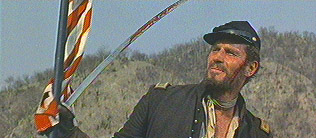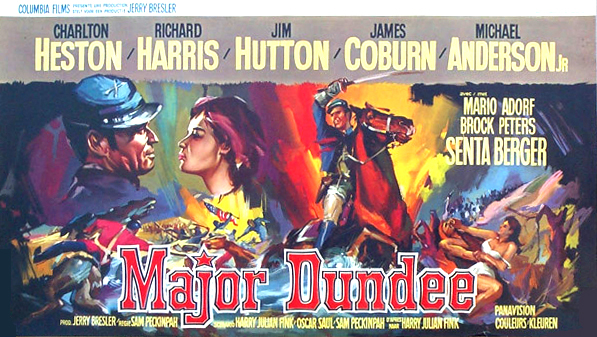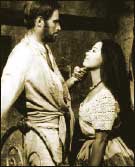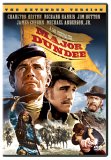| Reviews & Columns |
|
Reviews DVD TV on DVD Blu-ray 4K UHD International DVDs In Theaters Reviews by Studio Video Games Features Collector Series DVDs Easter Egg Database Interviews DVD Talk Radio Feature Articles Columns Anime Talk DVD Savant Horror DVDs The M.O.D. Squad Art House HD Talk Silent DVD
|
DVD Talk Forum |
|
|
| Resources |
|
DVD Price Search Customer Service #'s RCE Info Links |
|
Columns
|
|
|
Major Dundee: The Extended Version
Columbia/Sony has revived Sam Peckinpah's famous 'ruined masterpiece' Major Dundee, reinstating twelve minutes of virtually unseen footage and restoring the film to a quality much higher than the original color-by-Pathé prints. Even more remarkable is the studio's unprecedented step of putting a new score on the film. In this isolated case, that decision is quite a good thing. More on that subject below.
Hired in 1963 to make Major Dundee as a big-budget Road Show release, Peckinpah prepared a sprawling tale with extended subplots and thematic complexities. But just before filming began Columbia chopped both his budget and shooting schedule and told the ambitious director to scale the project down ... over a weekend. Peckinpah ignored those instructions and proceeded to shoot the film as planned, hoping Columbia would let him finish what he began. After one of the most embattled shoots in film history, the studio barred him from the lot and butchered the film in the editing room. His +/- 160-minute cut was chopped to a little over two hours. Some scholars have seen the outlines of a lost masterpiece in what remains.
There is a big difference between the old cut of Major Dundee and this new Extended Version: Although only 12 out of a possible 30 or 40 minutes have been restored, the average audience now has a chance to understand the show on a first viewing, and appreciate the scope of its story. The old cut had glaring continuity problems, starting with an awkward beginning that omitted the introduction of a main character and didn't properly establish the setting of Fort Benlin as a Union stockade for Confederate prisoners. Big pieces seemed to be missing from the second half of the show, which barely maintained a coherent storyline.

The twelve minutes of new material clear up a number of unanswered questions. Besides restoring three complete scenes, at least three others are augmented with more material. Dundee spends more time recovering from his leg wound in Durango, and the Christmas Eve knife fight between the one-armed Sam Potts (James Coburn) and the Indian scout Riago is allowed room to breathe. There are a number of little additions, sometimes individual shots: Corpses being buried at the Rostes Ranch; children watching Dundee's men mount up; young bugler Ryan (Michael Anderson Jr.) retiring with his Mexican nurse Linda (Begonia Palacios) to her private quarters.
The movie still has pacing problems, but the new material greatly increases our understanding of what Peckinpah was after. A confusing movie with poor continuity is now an intriguing movie ... a more complete assembly of a larger work. Imagine The Wild Bunch without an opening shootout, any of its flashbacks, and half of the character-building scenes removed. Take away the setup for the final battle, and remove any mention of what happens to the Angel character played by Jaime Sanchez. Rush the editing so that some sequences are too slow. Do little or no audio work, especially looping, so that ragged tracks from the set have to suffice. Edit the action scenes as quickly as possible and drop any violence or bloody detail that might be "in bad taste." That's what happened to Major Dundee.
The most important change in this Extended Version is the new music score. Over the years Savant has tried to show the old version to many people, including Peckinpah fans, and found that most had difficulty staying with the story because of its distracting, overbearing musical score. Veteran composer Daniele Amfitheatrof's serviceable themes are overused and poorly matched to the action. The main march is repeated too often, while dialogue sequences are drowned out by quotes from The Battle Hymn of the Republic and Dixie. An interesting love theme is also badly orchestrated, while battle scenes are overrun with unnecessary cues. Producer Jerry Bresler, himself once a songwriter, commissioned Mitch Miller and his Sing-Along Gang to chant the cheerful title march over shots of the aftermath of a massacre. The last straw is an oft-repeated musical sting that sounds like an electronic doorbell. The laughable cue pops up every time a key line of dialogue is uttered - "Until the Apache is taken or destroyed."
In any normal circumstance, replacing the music for a forty year-old movie would seem the definition of revisionist meddling, the kind of thing archivists and movie lovers hate. Monaural films are routinely being remixed in stereo sound, effectively altering film history in the name of commercial necessity. But Major Dundee was rescored not as a commercial gambit but to allow audiences access to what remains of Peckinpah's vision. The original score was imposed on the film in a truly slipshod post-production process after the director had been locked out of the studio.
The new score was composed and recorded by Christopher Caliendo using two large orchestras and a mariachi band. The first thing one notices is that the new Extended Version has a lot less music overall. The new silence behind dramatic scenes allows us to listen to Peckinpah's careful dialogue without a constant musical commentary. The music in the battle scenes is much more restrained. Caliendo's new themes are more serious and less melodic, and in many instances fit the mood of the picture better. For instance, the Mexican fiesta previously had the same folk song repeated on a loop. The new Mariachi music is much more variegated and seems to be coming from the musicians on screen.
My only personal criticism of the new score is that it sometimes seems too sombre, playing mournful notes in high-adrenalin scenes such as thee aftermath of the final battle. The new interpretation has tension but little in the way of grandeur. Also, the original tracks on the picture were so thin for sound effects, foley and walla that some scenes are far too quiet when the music is removed. The film was not retracked or remixed in any way except to change the music; and a few moments suffer in an odd silence.
I think the rescoring is a positive step and a valuable experiment unique to this situation. It does not play like an attempt to 'jazz up' an old movie by meddling with the soundtrack. The most flagrant rumor I've heard of a comparable situation is Brian De Palma's Scarface. I am told some executives wanted to re-score it with hip-hop music to make it appeal to today's gangsta-rap audiences. Reportedly, De Palma said no.
Columbia reports that the Extended Version will be maintained in 35mm with both scores, and the upcoming DVD will have both scores as well. The old 1965 version will not be retired.
The experts say that Major Dundee could never be reconstituted in Sam Peckinpah's cut; even if all the daily negative and audio could be located, the producer did not retain his all-important work picture or documentation that could make a recut possible. The extra twelve minutes of this Extended Version were part of the film's full finish, and were cut out at the very last minute. At least parts of it were shown in a couple of foreign territories, but not in England or America. 1

Viewers will want to know about the substantial content still missing from Major Dundee. The movie was meant to begin with the Halloween night massacre at the Rostes Ranch, a legendary opening that was discussed in screenwriting classes at UCLA. All we see of it now is a bit of footage peeking through the 'burning diary' opening optical. It introduces us to Lt. Brannin (Jody McCrea), the Custer-like young officer we see being roasted over a fire. Brannin wants to hang the scout Riago, who he thinks has misled the patrol away from Sierra Charriba. Later on Riago is discussed by various characters, especially by Sam Potts and Dundee. The last major addition in the Extended Version finally shows us whether or not Riago is a loyal trooper.
Other excised scenes highlighted the blatant illegality of Major Dundee's self-invented mission. More than anything else, Dundee wants to get out of the military doghouse and back into the war. He exceeds his orders by searching for Charriba, and his recklessness results in the loss of dozens of soldiers. Making a crusade out of catching Charriba is the only way he can avoid punishment, and if he's lucky, win career-enhancing applause and approval. In the script, Captain Waller (Karl Swenson) sends a runner to General Carlton to have Dundee arrested for flagrantly illegal acts like stealing supplies from his own army. Dundee is less like Captain Ahab, and more like Oliver North, an opportunist saving his skin by claiming a higher purpose.
Although his rival Ben Tyreen is intuitively a finer officer, Dundee's reckless plan works for one reason: Once his command crosses the Rio Grande into Mexico, they cease being a motley group of ethnic, regional and political enemies and take on a communal identity as Americans. In a newly-restored scene, Dundee's officers energetically propose the final trap for Sierra Charriba - working as a team. The shave-tail lieutenant becomes a seasoned officer, and the hateful rebel ends up championing the flag he once formally damned.
What Peckinpah learned from Major Dundee was put to good use on his next film, a much happier experience. Dundee still can't touch the The Wild Bunch but has qualities of its own and a fascinatingly complex script that stacks up as a cautionary national epic for a nation entering the Vietnam war. Interestingly, in Peckinpah's shooting script, just as the survivors of the troop prepare to re-enter Texas, Sam Potts points out a telling detail in the brush at their feet: Sierra Charriba's sub-chief Guero has left another Apache marker-gauntlet, another lance with a broken saber and a bloody soldier's tunic. Not all of the Apaches have been killed, and there may be more awaiting them on the trail. For both Major Dundee and his ambitious nation, the war will indeed last forever. 2
Perhaps because it is an unfinished, killed-in-the-womb masterpiece with a marvelous script of great potential, Major Dundee is Savant's favorite movie. With this Extended Version release, I'm hoping that its admirer base will grow larger and that more Sam Peckinpah fans will see it for what it is - surely not the writer/director's best work, but the one closest to his personal vision and political philosophy.
Reviewed April 4, 2005
Footnotes:

1. Researcher Darren Gross located long prints in an archive in Finland in 2001; the Academy reviewed a French print that had some of that material but also censored much more, especially anti-French sentiments. Darren determined that the final "Riago" scene may have been in English prints. Savant has a 16mm print of the movie that contains this cut scene, and always thought it was a slightly longer TV cut. I can't see why anyone would want to cut some of the Extended Version footage, but the Riago scene might be dropped because it is so gory, and the Durango scene has a lot of Spanish dialogue that the studio probably thought was a waste of time. Producer Bresler fought Peckinpah all down the line to remove violence and blood from the movie, and a main point of contention in their bitter post-production correspondence was a shot of bugler Ryan dipping a ladle of water from a stream, and coming up with a dipper full of blood. Bresler harped on the shot as disgusting, something he'd never allow in a movie. A solemn statement of ethics from a man who made Gidget movies.
Return
2. Original Columbia program notes state that the tale was based on a true story, but that seems to be an error sourced from Harry Julian Fink's first treatment - which only pretends that the story is a true one.
By the way, as we learned from research on The Good, The Bad and the Ugly there were plenty of Yankee troops in Colorado and New Mexico during the Civil War, partially as a deterrent to the French. Mexico's European rulers were engaged in their own Civil War with the Juarista revolutionaries; if things were otherwise they might have used the distraction of our War Between the States to try and reclaim the Western territories we'd seized from Mexico in 1848. (Thanks for this observation from Beverly Warren.)
Return
| |
|
| Popular Reviews |
| Sponsored Links |
|
|
| Sponsored Links |
|
|
| Release List | Reviews | Shop | Newsletter | Forum | DVD Giveaways | Blu-Ray | Advertise |
|
Copyright 2024 DVDTalk.com All Rights Reserved. Legal Info, Privacy Policy, Terms of Use,
Manage Preferences,
Your Privacy Choices | |||||||











